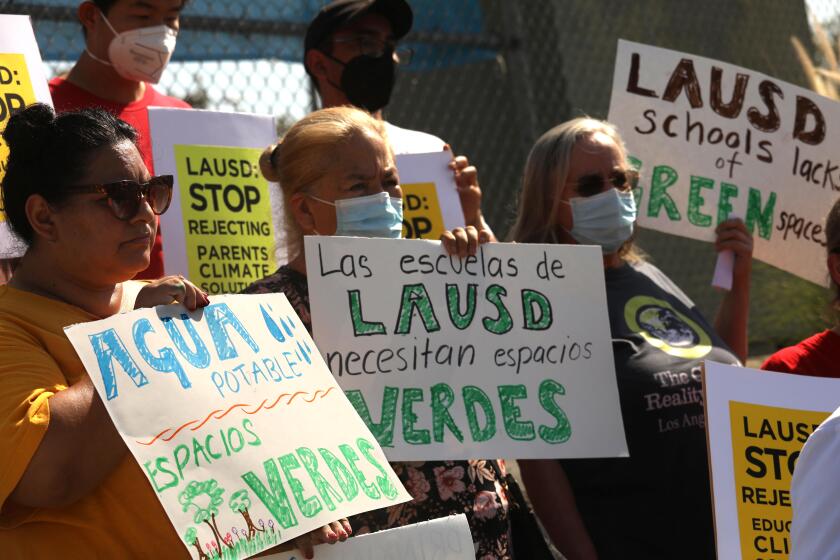It’s time to let the Chowchilla kidnappers go free
- Share via
One memorable moment during the Chowchilla kidnapping trial came during the testimony of one of the young victims. A girl testified that during the ordeal, she had tried to get everyone to sing, “If You’re Happy and You Know It, Clap Your Hands.”
“No one clapped,” she said in a small, plaintive voice.
The 1976 kidnapping was full of moments that set it apart from most crimes. The nation’s panic when an entire school bus of children disappeared along with their driver. The victims’ daring escape. The discovery that the kidnappers were not professional thugs, but three affluent young men.
These are some of the factors that make a case special in society’s collective emotional memory. They ensure that the events won’t be forgotten no matter how much time has passed and that anger at the perpetrators will remain long afterward.
But public emotions are not a solid foundation for true justice. The time has come to let the Chowchilla kidnappers go.
Thirty-five years after their crime, all three men, now far from young, are still in prison after numerous requests for parole were rejected. Some of the people who helped put them behind bars — a former judge, investigator and prosecutor — now say they should be freed. Much of the town of Chowchilla vehemently disagrees. But last week, a parole board recommended early release for one of them, Richard Schoenfeld. Even then, his release is 10 years away, and could be rescinded by Gov. Jerry Brown or any other governor in office before that time. His brother, James, and the third kidnapper, Fred Woods, will be eligible to apply again over the next couple of years.
The issues surrounding whether and when criminals should be paroled raise core questions about what our society means by criminal justice. Certainly, the primary reason for imprisoning lawbreakers is to protect society from further wrongdoing by them. It is expected to send a message to would-be criminals that the time is not worth the crime. But there also is an element of righteous retribution; our basic sense of fairness demands that people who do wrong should be punished for it. That sense is heightened when a crime strikes us as particularly heinous — such as the assassination of a beloved public figure, or an extraordinarily vicious assault.
Similarly, the overriding concern of a California parole board is supposed to be the protection of society — whether the convict poses a continuing danger or whether he or she has been rehabilitated and is unlikely to commit another crime. There has been little question that the Chowchilla kidnappers have been model prisoners. None of the people who oppose their release has given fear of recidivism as a reason.
Court decisions have been unclear on how much leeway parole boards have beyond this point. A 2005 state Supreme Court decision allowed parole boards to consider whether the crime had been “especially callous and cruel” even if they didn’t have objective criteria for that finding. Yet in 2008, the court ruled that parole decisions had to be based on whether the criminal posed a threat, not on the viciousness of the crime. A decision that year by a panel of the U.S. 9th Circuit Court of Appeals said that these measures of a crime’s gravity cannot be arbitrary; there must be some substantial reason for calling a crime heinous. But the full court overturned that decision in 2010.
Where do the Chowchilla kidnappers fit in all this? We would disagree with the former investigator who, in calling for their release, dubbed them “just dumb rich kids.” Dumb and rich, yes, but they also were amazingly callous. Never do they appear to have considered the trauma they were causing to 26 children, or the real risk that their victims could perish. The three men hijacked the bus at gunpoint, eventually forcing the children into a buried moving van and covering the escape hole with a metal plate weighted down by tractor batteries. After 16 hours, the bus driver and the children escaped.
Yet the kidnappers’ punishment has fully reflected the seriousness of their crime. In their 20s at the time of the kidnapping, they are now in late middle age and would be senior citizens by the time of their release. They have missed out on the prime of life, the years of building a career and creating a family — appropriately, given their despicable, senseless actions.
But in terms of sheer heinousness, it’s worth remembering that the kidnappers apparently did not intend to injure or kill anyone, and luckily for them, they didn’t. If they were not particularly solicitous toward their victims, neither were they vicious. In contrast, the followers of Charles Manson were horrifyingly brutal, which was why we opposed compassionate release for Sharon Tate’s murderer, Susan Atkins, several years ago. What mainly differentiates Chowchilla from other crimes is that it was intensely public. It panicked and then outraged an entire town; the bizarre nature of the crime drew national interest and sympathy for the children. But the public emotion roused by a crime does not make it inherently more heinous, and thus is not a valid reason on its own for denying parole.
We agree that parole boards need a degree of flexibility in making their decisions, but we also agree with the 9th Circuit panel that this flexibility should not be arbitrary. There should be rational, widely understood guidelines for measuring the heinousness of a crime and the likelihood that a felon will commit more of them. We do not believe such guidelines would call for lifelong imprisonment of the Chowchilla kidnappers.
More to Read
A cure for the common opinion
Get thought-provoking perspectives with our weekly newsletter.
You may occasionally receive promotional content from the Los Angeles Times.









